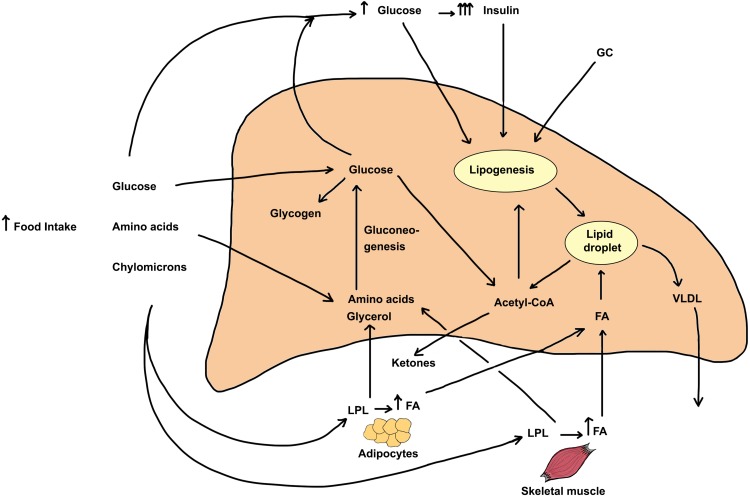Figure 1.
Metabolic pathways leading to excess triglyceride deposition in the liver and the effect of increased glucocorticoids on the pathways. The steady-state hepatic triglyceride content is determined by rates of TG formation and TG metabolism or secretion from hepatocytes. Several pathways and sources directly and indirectly serve to increase hepatic triglyceride content. These include 1) Increased appetite and food consumption. Following digestion of food, the bulk of the absorbed glucose is taken up by the liver (by GLUT2 transporters) and the rest is avidly taken up by the skeletal and cardiac muscle and adipose tissue by GLUT4 transporters that are stimulated by elevated insulin levels. The rise in blood glucose leads to increased secretion and blood levels of insulin, a response that is exaggerated by GC treatment. Amino acids are taken up mostly by liver and skeletal muscle. Chylomicrons release fatty acids (FA) and glycerol due to action of plasma LPL, and the released FA are taken up by adipose tissue, skeletal muscle as well as by the liver. GC excess stimulates tissue hormone-sensitive lipase and increases fatty acid and glycerol release from adipose tissue. 2) The uptake of FA by the liver represents the major pathway of lipid deposition in liver and this transport process is stimulated by GC. 3) Upon entry into the liver, amino acids and glycerol as well as glucose metabolites can form glucose through gluconeogenesis, a pathway that is stimulated by GC and inhibited by insulin. Finally, the elevated blood glucose and insulin both stimulate de novo fatty acid synthesis (lipogenesis), and excess GC in conjunction with elevated insulin synergistically stimulates this process. Two pathways mediate the decrease of triglycerides in intracellular stores. These include 1) the production and release of triglycerides as VLDL particles into the bloodstream, a process that is mildly stimulated by glucocorticoids and 2) β-oxidation of fatty acids, a metabolic pathway that is inhibited by glucocorticoids. All the major steps of TG metabolism in liver, adipose tissue, and skeletal muscle are affected by increased GC action. In sum, the net effect of excess glucocorticoids is to increase hepatic triglyceride stores leading to fatty liver.

